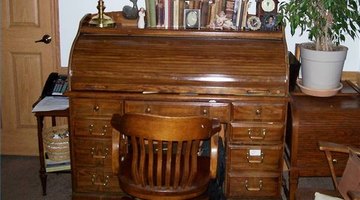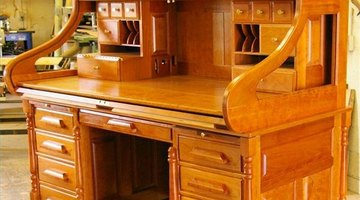How Does a Roll Top Desk Work?
Rolltop desks first appeared in offices during the nineteenth century, along with rise of the merchant class. They were designed specifically for clerks and businesspeople who needed a way to organize the ledgers, correspondence and other paperwork associated with operating a small business. Rolltop desks contained drawers, slots and shelves to organize these essential business papers and a way to lock them all up at the end of the day so that current work didn't have to be filed or locked in closets. The original rolltop desks were huge, some measuring as much as 8 feet wide and 6 feet deep. Today's desks are much smaller, tend to be more decorative than functional and fit in most home offices or dens.
A Whole Office in One Desk

How Does The "Roll" Part Work?

The rolltop desk is simply a "pedestal desk"--a top set on two columns of drawers--with a top case added. All rolltop desks have a three-sided cabinet that has tracks routed along the top and front edges of each side, lined with metal or plastic so that the roll part, or "tambour," will slide easily. Some desks continue the slats along each side down the back or under the desk deck, depending on the size and design of the desk. The tambour consists of half-round or flat slats, attached to a cloth or leather backing and attached to a wooden strip, or grip, then laid into the channel and moved up to open. A lock can be set into the grip and the deck of the desk to secure the roll when closed. The sides of a rolltop desk can be made in different shapes, from the simple quarter-round to the S-top to the exotic lute that extends out and loops back to the desk deck.
Adaptability and Individuality
Since rolltop desks were designed to be a self-contained office, the inside of the top cabinet was built for the type of business conducted by their owners. Each desk could be individualized by adding cubbies and other spaces designed for specific tasks. Some have long openings for ledgers, and others have sets of drawers for correspondence, keys or other items. Some have a set of slots to use for sorting--nineteenth-century "in" and "out" boxes. Large drawers with wood dividers provided places to file papers for future use or reference. If more room was needed, a console could be set on the shelf atop the tambour cabinet.
As paper became more plentiful and new materials like steel were adapted for the office, the rolltop desk lost favor. Today's smaller models, designed with just a few slots and drawers, most likely provide security for utility bills and birthday card stocks in family rooms and home offices.
Resources
Writer Bio
An avid perennial gardener and old house owner, Laura Reynolds has had careers in teaching and juvenile justice. A retired municipal judgem Reynolds holds a degree in communications from Northern Illinois University. Her six children and stepchildren served as subjects of editorials during her tenure as a local newspaper editor.
Photo Credits
- DRW & Associates, Inc
More Articles



